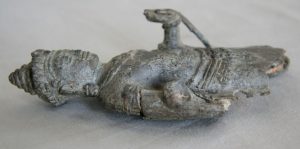A bronze workshop was discovered adjacent to the ancient Royal Palace of Angkor (Cambodia) on a site that that was first considered as a stone workshop. But the evidence found at the site such as half-finished bronze sculptures, hefty furnaces, fragments of unused metal and weighty crucibles that could hold up to two litres of molten bronze verified the assumptions made by archaeologists.

Carbon dating revealed that the workshop was likely in use from the 11th to the 12th century, the pinnacle of Angkorian civilisation under the reign of Jayavarman VII, the famed god-king. The reason the workshop’s discovery is so important is that it turns previously held assumptions about Angkorian bronze work. This workshop suggests that the production was centralised and industrial.

The method of bronze-making likely used at the workshop was lost-wax casting, which involved using a wax model of the sculpture that the artist would cover in a clay mould. The wax would then be melted out and filled with a molten alloy for moulding. The method was used in China, India and Europe.

(after The Phnom Penh Post)